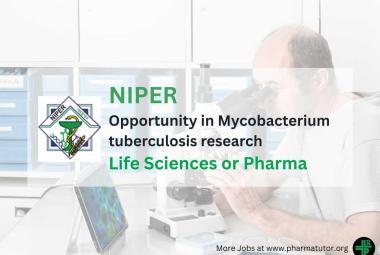{ DOWNLOAD AS PDF }
ABOUT AUTHORS:
Indra Prakash1*, Jugaldas Chudasama2, Pravin Gupta1, Rahul Dev1, Shashi Shekhar1, Mohit kumar2
1Sir Madanlal Institute of Pharmacy, AlampurHauz, Etawah, Uttar Pradesh, India
2Medicef Pharma, Jhar Majri, Baddi, Himachal Pradesh, India
indra.prakash117@gmail.com
ABSTRACT
The objective of present study was to develop the formulation of Fast Dispersible tablet of Amoxycillin & Potassium clavulanate and perform the in vitro bioequivalence study with trying to enhance the bioavailability of innovator formulation. Reduction in the dose of Amoxycillin and potassium clavulanate tablet was possible by developing Fast dispersible tablet. Fast dispersible tablets are designed to disintegrate quickly in the mouth or disperse in a spoonful of water to become a suspension. They are also divided into two or four parts for easy dose titration, and taste masked for patient compliance. These tablets are given to the children who have difficulty in swallowing so Total 05 formulations were made with different concentration of Crospovidone & MCC and fixed concentration of Croscarmellose sodium and Polacrilin Potassium by dry granulation method. The formulations were evaluated for weight variation, hardness, friability, disintegrating time, dissolution study. All the formulations shows uniform weight, hardness and friability data indicates good mechanical resistance of the tablet. All the tablets were disintegrated between 25-45Sec. The optimized (FR-5) formulation showed good disintegration time and release profile with maximum drug being released than marketed preparation at all-time intervals.
REFERENCE ID: PHARMATUTOR-ART-2280
|
PharmaTutor (ISSN: 2347 - 7881) Volume 2, Issue 11 Received On: 05/09/2014; Accepted On: 30/09/2014; Published On: 01/11/2014 How to cite this article: I Prakash, J Chudasama, P Gupta, R Dev, S Shekhar, M Kumar; Formulation and In Vitro Bioequivalence Study of Amoxycillin & Potassium Clavulanate Fast Dispersible Tablet; PharmaTutor; 2014; 2(11); 102-111 |
INTRODUCTION
In the world of pharmacy around 80% of the tablets manufactured are ingested orally. Administration of drugs through oral route is the most common and the easiest way to administer a drug. However, geriatric and bedridden pediatric, patient shows inconvenience swallowing conventional tablets or due to difficulties in swallowing with lesser amounts of water with the medication, because of large tablet size difficulties in swallowing, unable to tolerate the taste of many drugs when formulated as liquid dosage forms, resulting in poor patient compliance[1]. The rationalized approach in case of medication leads to the development of Fast Dispersible tablets. These are manufactured so that they disintegrate quickly in the mouth or disperse in a specified amount of water to become a suspension producing a pleasant tasting residue in the oral cavity that is easily swallowed and does not leave a bitter a unpleasant taste. Fast Dispersible tablets are the tablets which are need to be disintegrate quickly in the mouth. These tablets are given to the adults who dislike swallowing and to the children who have difficulty in swallowing and. For Successfully tablet formulation development involves the careful selection of ingredients in order to manufacture a robust solid dosage form. Choosing the appropriate excipients to perform a specific function in a tablet formulation, such as disintegration or lubrication can be critical to achieving acceptable manufacturing performance. Sweeteners, both naturally occurring and synthetic, are one type of functional excipients commonly used in fast dispersible tablet formulations to mask unpleasant tastes and facilitate pediatric dosing. Ideally Fast dispersible formulations should have smooth texture upon disintegration, pleasant taste and no bitter and unpleasant after taste. It can be take direct orally or after melt in lukewarm water, they are quickly disintegrate in the mouth and release their ingredients in the process and therefore, do not have much lag time as required for the disintegration of tablets before absorption from stomach.
In combination of Amoxycillin & Potassium clavulanate is available in various dosage forms like Film coated tablet, Modified release tablet, dry syrup, suspension. Due to high dose 625mg bis in die(for adults), tablet having a long and wide in size of 1 to 1.5 gm, so it is difficult to some patients(geriatric, bedridden, pediatric) to swallow the tablet. So in this research work prepared a fast dispersible tablet of Amoxycillin & Potassium Clavulanate tablet. The antibiotics are available in various dosage forms. Amoxycillin is an antibiotic of the penicillin type. It is effective against different bacteria such as H. influenzae, N. gonorrhea, E. coli Pneumococci, Streptococci, and certain strains of Staphylococci, It is used in the treatment of patients with acquired pneumonia or acute bacterial sinusitis due to confirmed or suspected beta lactamase pathogens. Bacterial resistance to the beta-lactamgroup of antibiotics is frequently due to the production of beta-lactamase which brings about inactivation of the anti-biotic. Potassium Clavulanate is a naturally occurring inhibitor of beta lactamase which is capable of rendering penicillin and cephalosporin resistant organisms sensitive. Prevent bacterial regrowth when free drug levels fall below the minimum inhibitory concentration (MIC) [2].
In-vitro Bioequivalence: According to US FDA two formulations are said to be bioequivalent if ″The rate and extent of absorption of the test drug do not show a significant difference from the rate and extent of absorption of the reference drug, when administered at the same molar dose of the therapeutic ingredient under similar experimental conditions in either single dose or multiple dose. For two orally administered drug products to be bioequivalent, they should be pharmaceutical alternative or pharmaceutical equivalent must exhibit the rate and extent of absorption[3].
PREFORMULATION STUDY
Identification of Amoxycillin& Potassium Clavulanate By HPLC(High Performance Liquid Chromatography:
Identification of Amoxycillin & Potassium Clavulanate were Performed by HPLC. According to Indian Pharmacopoeia if the Retention time of standard and test product is same then they are said to be similar products.
(a) Methodology & Procedure: In identification of APIs the column was C18 type, mobile phase was 7.8gm disodium hydrogen Ortho Phosphate, the flow rate of mobile phase was 1.5 ml/ min, Sample injected volume was 20 µl, and standard and test was prepared with the concentration of 100 mg in 100 ml water.
Mobile phase was prepared with 7.8 gm disodium hydrogen ortho phosphate. HPLC column was firstly wash with hot water and then with mobile phase for remove the previous solvents,then saturated the column to obtained the base line after that taken one trail to check retention time then run the standard and test product.
Evaluation of Granules: Bulk density was determined with 20 gm sample. Take 20 gm sample, after weighing sample was measured in measuring cylinder in ml and calculate the bulk density. After that Tap measuring cylinder for 100 times then note the volume of powder after tapping, by this determine the Tapped density. By the readings of bulk and tapped density determined the Carr’s and Hausner’s ratio.
(a) Bulk density: The bulk density of a powder is the ratio of the mass of an untapped powder sample and its volume including the contribution of the interparticulate void volume. The bulk density is expressed in grams per milliliter (g/ml).
(b) Tapped Density: The tapped density is an increased bulk density attained after mechanically tapping a container containing the powder sample. The tapped density is obtained by mechanically tapping a graduated measuring cylinder or vessel containing the powder sample. After observing the initial powder volume or mass, the measuring cylinder or vessel is mechanically tapped, and volume or mass readings are taken until little further volume or mass change is observed.
(c) Carr’s Index: The interparticulate interactions influencing the bulking properties of a powder are the interactions that interfere with powder flow, a comparison of the bulk and tapped densities can give a measure of the relative importance of these interactions in a given powder..Carr’s index limit-5-11(Excellent), 12-16(Good), 18-21(Fair to passable).[4]
CARR’S INDEX(%) =(TAPPED DENSITY – POURED DENSITY) X 100
TAPPED DENSITY
(d) Hausner’s Ratio: it is Tapped density/ bulk density. It is depend upon these two densities. Hausner’s Ratio limit:1.00-1.11(Excellent), 1.12-1.18(Good), 1.19-1.25(Fair).[4]
(e) Angle of Repose:Angle of repose was determined by funnel method.By determining Angle of Repose determine the flow properties of powder.Greater angle of repose indicate poor flow. It should be less than 30°. & can be determined by following equation.
tanθ= h/r.,where, θ= angle of repose, h=height of pile, r= radius.
Limit- <25(Excellent)25-30 (Good), 30-40(passable)(16).[4]
MATERIALS AND METHODS
Materials- Amoxycillin Trihydrate & Potassium Clavulanate was produced from DSM Sinochem Pharma, Microcrystalline cellulose from Mingtai chem. Cells co. Ltd., Crospovidone from Asbro Pharma,Croscarmellose sodium from Base Chemicals, Polacrillin Potassium from Asbro Pharma, Magnesium stearate from Suzong Chemicals,
Aspartame from Biocon Ltd and Aerosil from Wacker.
Method: Dry Granulation
Raw material → weighing → Sifting → mixing → slugging → milling → screening → Blending → compression.[5]
Procedure: Sifting is the first step of formulation of Amoxycillin and clavulanate Fast Dispersible tablet was sifting (Table 1) Then Dry Blending, In this step Load the sifted material of step first in the Octagonal blender & mix for 15 minutes. Then Compaction by roll compactor at the temperature of 23-25C. Then Granulation, Pass the compacted material through Oscillatory Granulator through 2.5 mm screen. Then Sifting, Sift the milled material of previous step through 18 # S.S. mesh.ThenDrying,After sifting Dry the granular power in Vacuum Tray Dryer for Two hours at 600C temperature and vacuum at 710 ± 10 mm Hg.Then Sifting, Sift Potassium Clavulanate through sifter fitted with sieve # 30.Then Blending,After Sifting Load the Drying material in the Octagonal blender and add Potassium Clavulanate, Aerosil& Magnesium Stearate mix for 30 minutes.After that Compression,final step was compression of tablet of 27 stations D tooling machine is used to formulate Amoxycillin & potassium clavulanate Fast Dispersible tablet.
Table 1: Sifting process of API & excipients
|
S.No. |
RAW MATERIAL |
SIEVE NO. |
|
1. |
Amoxycillin Trihydrate |
18 |
|
2. |
Potassium Clavulanate |
30 |
|
3. |
Micro crystalline Cellulose |
30 |
|
4. |
Crospovidone |
30 |
|
5. |
Talcum |
60 |
|
6. |
Magnesium Stearate |
30 |
|
7. |
Aerosil |
30 |
|
8. |
Polacrilin potassium |
30 |
|
9. |
Croscarmellose sodium |
30 |
|
10. |
Flavour pineapple |
30 |
|
11. |
Flavour mint |
30 |
|
12. |
Aspatame |
30 |
|
Sr. No. |
Name of Raw Material |
FR-1 (mg) |
FR-2 (mg) |
FR-3 (mg) |
FR-4 (mg) |
FR-5 (mg) |
|
01. |
Amoxycillintrihydrate |
200 |
200 |
200 |
200 |
200 |
|
02. |
Potassium Clavulanate |
28.5 |
28.5 |
28.5 |
28.5 |
28.5 |
|
03. |
Micro Crystalline Cellulose(Plain) |
55.625 |
75.625 |
65.625 |
45.625 |
35.625 |
|
04. |
Crospovidone |
49.957 |
29.957 |
97.957 |
59.957 |
69.957 |
|
05. |
Talcum |
0.225 |
0.225 |
0.225 |
0.225 |
0.225 |
|
06. |
Magnesium Stearate |
13.125 |
13.125 |
13.125 |
13.125 |
13.125 |
|
07. |
Aerosil |
16.250 |
16.250 |
16.250 |
16.250 |
16.250 |
|
08. |
PolacrilinPottassium |
32.50 |
32.50 |
32.50 |
32.50 |
32.50 |
|
09. |
Croscarmellose Sodium |
57.813 |
57.813 |
57.813 |
57.813 |
57.813 |
|
10. |
Flavour Pineapple |
19.370 |
19.370 |
19.370 |
19.370 |
19.370 |
|
11. |
Flavour Mint |
1.010 |
1.010 |
1.010 |
1.010 |
1.010 |
|
12. |
Aspartame |
25.625 |
25.625 |
25.625 |
25.625 |
25.625 |
Table No. 2: Composition of all formulations of 228.5mg Fast Dispersible tablet
NOW YOU CAN ALSO PUBLISH YOUR ARTICLE ONLINE.
SUBMIT YOUR ARTICLE/PROJECT AT editor-in-chief@pharmatutor.org
Subscribe to Pharmatutor Alerts by Email
FIND OUT MORE ARTICLES AT OUR DATABASE
Evaluation of tablet:
Disintegration time: it was determined by using USP disintegrator by using 6 tablets at the temperature of 24-26 C.[6] The Batch FR-5 shows best disintegration time (25 Sec.) and marketed formulation disintegrated at 58 Sec.(Figure 9)
Average weight: To study weight variation, 20 tablets of each formulation were weighed using an electronic balance (Table no. 4)
Friability: This was determined by weighing 10 tablets after dusting, placing them in the friabilator and ro-tating the plastic cylinder vertically at 25 rpm for 4 min. After dusting, the total remaining weight of the tablets was recorded and the percent friability was calculated, the friability was ranged from 0.24 to 0.26 (Table 4).
Hardness: The resistance of tablets to shipping or breakage, under conditions of storage,transportation and handling before usage depends on its hardness. The hardnessof tablet of each formulation was measured by Monsanto hardness tester10. The hardness was measured in terms of kg/cm2, it was recorded in between 4 to 7 (Table No. 4).
Thickness,Width,Length: These were determined using Vernier caliper. Five tablets were randomly selected for the determination of thickness and diameter with the help of vernier caliper(Table No. 4).
Uniformity of dispersion: Those tests were determined and pass the uniformity of dispersion of all formulations.[6]
In-vitro release study: The release of Amoxycillin & Potassium Clavulanate from Chewable tablets was determined by using Dissolution type II test apparatus. The dissolution test was performed using 900 ml water at 37 ± 0.5C temperature and at 75 rpm. At specified time intervals, samples of 5 ml were withdrawn from the dissolution medium and that amount was replaced with fresh medium to maintain the volume constant. The samples were filtered and determine % Release at HPLC.
RESULTS:
Preformulation study: Solubility, identification and assay of Active pharmaceutical ingredients by HPLC, flow properties of granules were determined.
Solubility: Amoxycillin was slightly soluble in water, methanol and ethanol and Potassium Clavulanate was freely soluble in water and methanol.
Identification: Identified successfully. It was performed by HPLC. The retention time of Standard curve and test curve were same. RT of standard Amoxycillin was 2.060 and RT of test was also 2.06(fig.1&2), RT of standard Potassium Clavulanate was 1.924 and RT of test was also 1.928 (fig.3&4), The RT of mixture of Amoxycillin & Potassium Clavulanate standard was 4.082 & 2.143 and RT of test was 4.082 & 2.143(fig.5&6).
Flow Properties: Evaluation of granules was determined successfully. The Results were in limits, The Carr’s index of all batches was with in the limit and the Hausner’s ratio was also in limit. Angle of repose was also successfully determined. Refer (Table 3).
Evaluation of tablets: Tablets were evaluated for weight variation, hardness, friability, Disintegration time, Uniformity of dispersion and Equivalent Relative Humidity, Assay and dissolution study. Tablets were having uniform weight, hardness and friability data indicates good mechanical resistance of the tablets. First the tablets were evaluated for average weight; the tablets show values between 499 mg to 502 mg. The tablets were evaluated for length, thickness and width and it was found to be within the limits. Lengths of all batches were found from 15.15 to 15.17, Thickness was from 5.15 to 5.18, widths of all batches including marketed formulation were 8.16 to 8.19 Disintegration time was found in between the 25 to 45 Sec. The Batch FR-5 shows best disintegration time it was 25 Sec and disintegration of marketed formulation was 58 sec. which was greater than FR-5 batch. The tablets also evaluated for the % ERH, it was with in the limit (0.05 to 0.07) and uniformity of weight and found to be within the limit. (Table No. 4)
The % release of batch FR-1 to FR-2 were 50-82 % and from batch FR-3 to FR-5 was within the limit of 72-98 %. Batch FR-5 shows better release compare to marketed formulation. Batch FR-5 shows 99.68% Amoxycillin (Figure7) & 99.12% of Potassium Clavulanate (Table No.5, Figure 8), Marketed formulation shows 95.593 % Amoxycillin & 96.827% of Potassium Clavulanate (Table No.6, Figure 10, 11).
Table No. 6 shows the Comparative Dissolution Profile of Maketed formulation and innovator formulation. At each interval time Innovator formulation shows better release properties than marketed formulation
Table No 3: Pre compression Studies
|
S.No. |
Test |
FR-1 |
FR-2 |
FR-3 |
FR-4 |
FR-5 |
|
1 |
Bulk density(gm/ml) |
0.460 |
0.471 |
0.462 |
0.465 |
0.460 |
|
2 |
Tapped density(gm/ml) |
0.532 |
0.522 |
0.538 |
0.535 |
0.532 |
|
3 |
Carr’s index |
13.53 |
9.77 |
13.26 |
20.75 |
13.08 |
|
4 |
Hausner’s ratio |
1.15 |
1.10 |
1.16 |
1.16 |
1.15 |
|
5 |
Angle of repose(degrees) |
22.4 |
22.2 |
22.6 |
22.5 |
22.4 |
Table No.4: Post compression Studies of formulation FR-1-to FR-5& MP
|
Name of Test |
FR-1 |
FR-2 |
FR-3 |
FR-4 |
FR-5 |
MP |
|
|
Avg.Wt. (mg) |
499 |
502 |
501 |
499 |
500 |
503 |
|
|
Hardness(Kg/cm2) |
7 |
6 |
6 |
5 |
4 |
6 |
|
|
Friability (%) |
0.24 |
0.26 |
0.25 |
0.26 |
0.26 |
0.27 |
|
|
Length(mm) |
15.15 |
15.17 |
15.16 |
15.15 |
15.16 |
15.22 |
|
|
ERH % |
0.05 |
0.04 |
0.06 |
0.05 |
0.05 |
0.07 |
|
|
Thickness(mm) |
5.16 |
5.15 |
5.16 |
5.18 |
5.16 |
5.20 |
|
|
Width(mm) |
8.17 |
8.16 |
8.18 |
8.19 |
8.16 |
8.20 |
|
|
Disintegration time(Sec.) |
45 |
42 |
35 |
28 |
25 |
58 |
|
|
Uniformity of dispersion |
pass |
pass |
pass |
pass |
pass |
pass |
|
|
Assay |
Amoxycillin (%) |
95.1 |
98.3 |
98.5 |
98.7 |
98.9 |
98.5 |
|
Potassium Clavulanate (%)< |
|||||||









